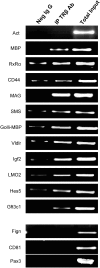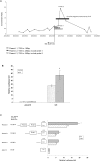Identification of thyroid hormone receptor binding sites and target genes using ChIP-on-chip in developing mouse cerebellum
- PMID: 19240802
- PMCID: PMC2643481
- DOI: 10.1371/journal.pone.0004610
Identification of thyroid hormone receptor binding sites and target genes using ChIP-on-chip in developing mouse cerebellum
Abstract
Thyroid hormone (TH) is critical to normal brain development, but the mechanisms operating in this process are poorly understood. We used chromatin immunoprecipitation to enrich regions of DNA bound to thyroid receptor beta (TRbeta) of mouse cerebellum sampled on post natal day 15. Enriched target was hybridized to promoter microarrays (ChIP-on-chip) spanning -8 kb to +2 kb of the transcription start site (TSS) of 5000 genes. We identified 91 genes with TR binding sites. Roughly half of the sites were located in introns, while 30% were located within 1 kb upstream (5') of the TSS. Of these genes, 83 with known function included genes involved in apoptosis, neurodevelopment, metabolism and signal transduction. Two genes, MBP and CD44, are known to contain TREs, providing validation of the system. This is the first report of TR binding for 81 of these genes. ChIP-on-chip results were confirmed for 10 of the 13 binding fragments using ChIP-PCR. The expression of 4 novel TH target genes was found to be correlated with TH levels in hyper/hypothyroid animals providing further support for TR binding. A TRbeta binding site upstream of the coding region of myelin associated glycoprotein was demonstrated to be TH-responsive using a luciferase expression system. Motif searches did not identify any classic binding elements, indicating that not all TR binding sites conform to variations of the classic form. These findings provide mechanistic insight into impaired neurodevelopment resulting from TH deficiency and a rich bioinformatics resource for developing a better understanding of TR binding.
Conflict of interest statement
Figures






Similar articles
-
Identification of thyroid hormone receptor binding sites in developing mouse cerebellum.BMC Genomics. 2013 May 23;14:341. doi: 10.1186/1471-2164-14-341. BMC Genomics. 2013. PMID: 23701648 Free PMC article.
-
Barhl1 is directly regulated by thyroid hormone in the developing cerebellum of mice.Biochem Biophys Res Commun. 2011 Nov 11;415(1):157-62. doi: 10.1016/j.bbrc.2011.10.041. Epub 2011 Oct 18. Biochem Biophys Res Commun. 2011. PMID: 22027146
-
Gene-specific changes in promoter occupancy by thyroid hormone receptor during frog metamorphosis. Implications for developmental gene regulation.J Biol Chem. 2005 Dec 16;280(50):41222-8. doi: 10.1074/jbc.M509593200. Epub 2005 Oct 19. J Biol Chem. 2005. PMID: 16236718
-
Current perspectives on the role of thyroid hormone in growth and development of cerebellum.Cerebellum. 2003;2(4):279-89. doi: 10.1080/14734220310011920. Cerebellum. 2003. PMID: 14964687 Review.
-
Syndrome of resistance to thyroid hormone: insights into thyroid hormone action.Proc Soc Exp Biol Med. 1996 Jan;211(1):49-61. doi: 10.3181/00379727-211-43951. Proc Soc Exp Biol Med. 1996. PMID: 8594618 Review.
Cited by
-
Deficiency of type 2 iodothyronine deiodinase reduces necroptosis activity and oxidative stress responses in retinas of Leber congenital amaurosis model mice.FASEB J. 2018 Jun 6;32(11):fj201800484RR. doi: 10.1096/fj.201800484RR. Online ahead of print. FASEB J. 2018. PMID: 29874126 Free PMC article.
-
Gene expression changes of interconnected spared cortical neurons 7 days after ischemic infarct of the primary motor cortex in the rat.Mol Cell Biochem. 2012 Oct;369(1-2):267-86. doi: 10.1007/s11010-012-1390-z. Epub 2012 Jul 21. Mol Cell Biochem. 2012. PMID: 22821175 Free PMC article.
-
The protective variant rs7173049 at LOXL1 locus impacts on retinoic acid signaling pathway in pseudoexfoliation syndrome.Hum Mol Genet. 2019 Aug 1;28(15):2531-2548. doi: 10.1093/hmg/ddz075. Hum Mol Genet. 2019. PMID: 30986821 Free PMC article.
-
Transport, Metabolism, and Function of Thyroid Hormones in the Developing Mammalian Brain.Front Endocrinol (Lausanne). 2019 Apr 3;10:209. doi: 10.3389/fendo.2019.00209. eCollection 2019. Front Endocrinol (Lausanne). 2019. PMID: 31001205 Free PMC article. Review.
-
Development of a novel output value for quantitative assessment in methylated DNA immunoprecipitation-CpG island microarray analysis.DNA Res. 2009 Oct;16(5):275-86. doi: 10.1093/dnares/dsp017. Epub 2009 Sep 18. DNA Res. 2009. PMID: 19767598 Free PMC article.
References
-
- Bernal J. Thyroid hormone receptors in brain development and function. Nat Clin Pract Endocrinol Metab. 2007;3:249–259. - PubMed
-
- Zoeller RT, Rovet J. Timing of thyroid hormone action in the developing brain: clinical observations and experimental findings. J Neuroendocrinol. 2004;16:809–818. - PubMed
-
- Delange F. Neonatal screening for congenital hypothyroidism: results and perspectives. Horm Res. 1997;48:51–61. - PubMed
-
- Harris KB, Pass KA. Increase in congenital hypothyroidism in New York State and in the United States. Mol Genet Metab. 2007;91:268–277. - PubMed
Publication types
MeSH terms
Substances
LinkOut - more resources
Full Text Sources
Miscellaneous

